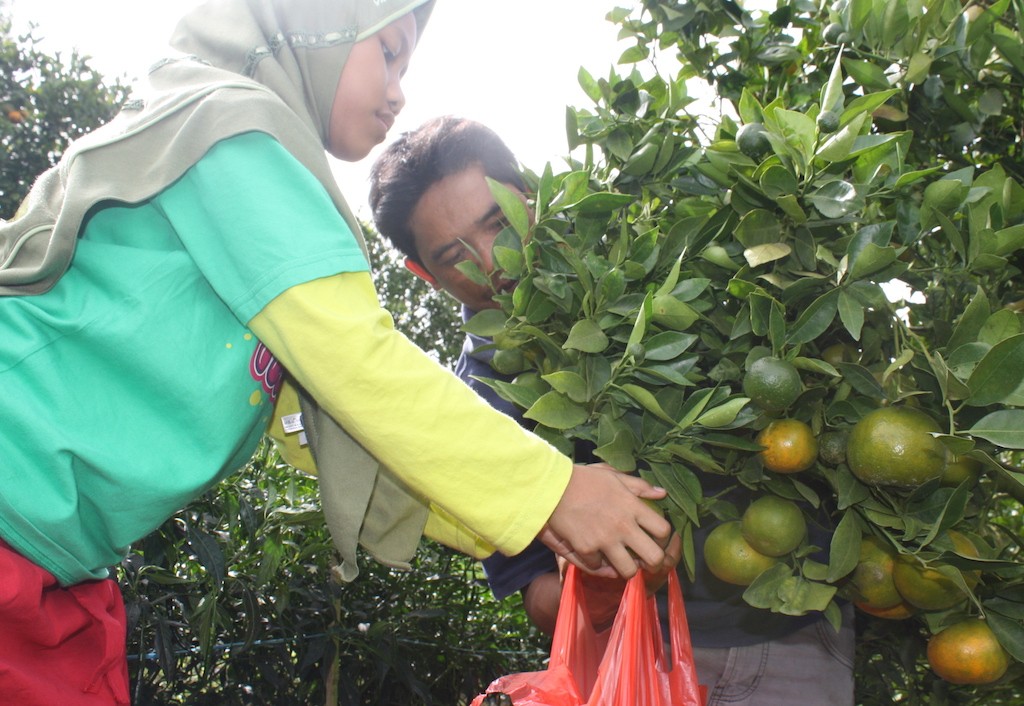Popular Reads
Top Results
Can't find what you're looking for?
View all search resultsPopular Reads
Top Results
Can't find what you're looking for?
View all search resultsForeign oranges put Indonesia's own in tight squeeze
Inflows of imported oranges have put the country’s own exotic orange variants in a tight squeeze, further jeopardizing local businesses that are already facing a hard time against their foreign counterparts.
Change text size
Gift Premium Articles
to Anyone
Inflows of imported oranges have put the country’s own exotic orange variants in a tight squeeze, further jeopardizing local businesses that are already facing a hard time against their foreign counterparts.
The saying “don’t judge a book by its cover” does not apply to the sales of Mandarin oranges at Kopro Market in Grogol, West Jakarta.
Tuti, who has been selling fruits for 39 years at the market, said she had stopped selling Medan oranges due to their unappealing appearance and low quality.
“They are less sweet and pale now,” she told The Jakarta Post recently, attributing the quality to the numerous eruptions of Mount Sinabung in North Sumatra.
(Read also: Pakistan boosts orange exports to Indonesia)
What sells now are imported oranges, such as the Mandarin variety from China and Navel from Australia, Egypt, Turkey and the United States, thanks to their bright, smooth skin and fresher taste.
A similar situation was also found at Kebayoran Lama Market in South Jakarta, with more variants of imported oranges put on display for buyers.
Rising consumption has made Indonesia a hot market for orange-exporting countries. Pakistan, for instance, has begun to offer its Kinnow oranges at giant retailers in Indonesia.
Last year it exported US$23 million-worth of Kinnow oranges to Indonesia and expects to see the figure grow significantly in Indonesia, according to the Pakistani Embassy.
Various statistics show that the volume of imported oranges has indeed been on the rise over the past few years. From 2006 to 2015, the volume rose by an average 10.4 percent, with the total figure reaching 106,140 tons in 2015.
China remains the largest import source in terms of volume, followed by Pakistan, Australia, South Africa and Egypt.
Local production, on the other hand, has not grown as rapidly as imports, as it fell by an average 30 percent during the same period, as shown by data from the Agriculture Ministry.
Tertib Ginting is among orange farmers feeling the pinch of rising imports. He claimed his earnings had dropped drastically ever since imported oranges entered the local market.
“They [producers of the imported oranges] dare to sell at a low price, while we cannot do that because operating costs are already high. Farmers have to incur losses from the unsold oranges in the market,” said the farmer from Gurukinayan village in Karo, North Sumatra.
Tertib’s Medan oranges are transported to Jakarta from Karo at Rp 2,500 (18 US cents) per kilogram, making it difficult for him to set a high selling price.
The current maximum price for Medan oranges is Rp 24,000 per kg, while imported Navel oranges can sell for around Rp 28,000 per kg.
The government, meanwhile, does not have a set quota for orange imports and only applies a certain amount of measures to “balance” supply and demand.
The Agriculture Ministry’s fruits and flowers director, Sarwo Edhi, said importers must first obtain a horticulture product import recommendation (RPIH), which is based on the ministry’s own monthly supply and demand.
Another measure includes limiting the amount of ports that can facilitate fruit imports.
Pakistani oranges can enter through Tanjung Priok Port in Jakarta, Tanjung Perak Port in East Java, Belawan Port in North Sumatra, Soekarno Hatta Port in South Sulawesi and SoekarnoHatta International Airport in Banten province.
On the other hand, oranges from China can enter those ports, except Tanjung Priok.
The ministry estimates demand will stand at 1.94 million tons this year, while local production will reach 2.13 million tons. An orange shortage will occur from the beginning of the year until April, followed by surplus until year-end.
Meanwhile, National Agriculture Council chairman Benny Kusbini said the government should help and push horticulture sectors to compete against imported products and start a campaign to encourage people to consume local products.
“It can be by improving overall product quality, introducing a refrigeration system for post-harvest distribution and providing more space for local products at markets.” (ecn/dra/yon)
Stefani Ribka in Jakarta and Apriadi Gunawan in Medan contributed to the story.










